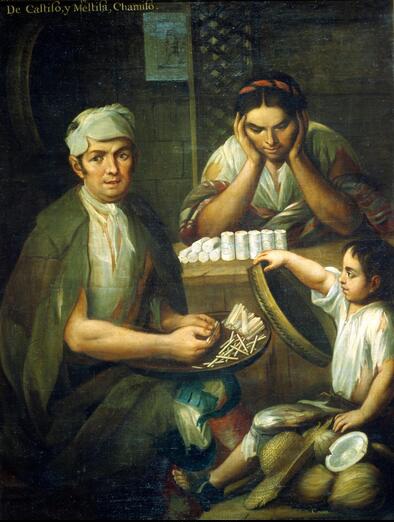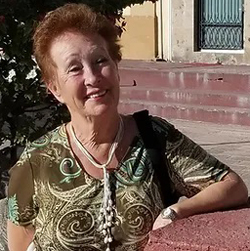by Natalie Taylor
Casta paintings, a particular genre of Mexican secular art, depict the mixing of disparate ethnic groups, with specific names for their progeny. Casta paintings appeared in Mexico at the beginning of the 18th century, in a style reminiscent of Goya's paintings. Usually the paintings were commissioned by the Viceroy, as a type of catalog to identify the racial mixtures in the New World. The paintings followed a recipe—the trilogy of father, mother and offspring, in a series showing the various castes. They were clearly hierarchical in nature, where the lighter the skin, the higher the individual's position in society. These paintings were displayed in official public spaces—museums, universities, and high ranking officials' residences and palaces, as well as in unofficial spaces when private collections would be opened up to limited public viewing.
We do not have any public examples of casta paintings in San Miguel de Allende. However, we do have religious works done by notable novo Hispanic casta painters—Juan Rodríguez Juárez, Miguel Cabrera, and Juan Patricio Morlete Ruiz. Their religious works grace the walls of many churches in the city, and can be appreciated even now. I will be writing about each of these artists separately in future columns, but in this article I will concentrate on casta paintings themselves.
Casta paintings are specific to Latin America, conceived in, and for the Spanish colonies. The word is derived from the Latin castus, meaning pure, from which root the English word chaste derives as well. The original meaning was sexual purity, but in New Spain it related to purity of blood; white Spanish blood untainted. It was an almost inevitable consequence of Spain's obsession in maintaining a white, Christian population, and the ugly history of Spain's forced conversions, expulsions and massacres of non-Christians during the 15th through the 17th century. The need to have clear definitions of who should be considered "new Christians" led the Inquisition to create the Statutes of Cleanliness of Blood, in Spain and America. Placing importance on genealogy and having "pure lineage," led to the caste system in New Spain, and the proliferation of casta paintings.
In the New World, the amount of someone's pigment, or lack thereof, became the measure of their worthiness, impacting all aspects of their lives. Casta paintings became a means of categorizing the population according to parentage. The highest level was reserved for white Spaniards born in Spain—the minority with wealth and power—disparagingly called "gachupines." Perpetuating the notion of poor ancestry gave a reason to exclude the mixed population from education, politics, and power in the clergy.
Beyond the ugliness of classifying human beings, the names invented for each racial mix were demeaning. Most were related to animals or the breeding of horses. Mulato comes from mule, lobo is wolf, and coyote is self-explanatory. But many terms were quite colorful, albeit ridiculous, such as torna atras (turn back) which referred to a mixed-race person showing the physiognomy of one of the "original races." Or tente en el aire—hold yourself in mid-air; name given to the child of a mulato mother and a quadroon father. If this person would someday marry a mestizo, their progeny would be called no te entiendo—I don't understand you!
Aside from cataloguing and controlling the population, the Spanish crown was very interested in showing the world its power and the wealth of their conquered territories. For this reason, the casta painters were expected to show wealth, and the abundance of unique flora and fauna. No plants or animals are shown in the above casta painting of Miguel Cabrera, but wealth and opulence definitely is. The Spaniard father in the painting is dressed in rich clothing—velvet, silk, embroidered leather, with elegant hat on his knee. At his side is a dagger, and a blunderbuss—he appears powerful, and fully armed. There is an interesting additional detail. The man has a cigarette in his mouth, another tucked behind his ear, and what is possibly a case with tobacco by his leg. Although this does not seem like an important element, it actually is quite significant. It goes back to what I initially mentioned—the Spanish crown's desire to highlight the riches of the New World, a world they owned and exploited. Tobacco was one of the staples that had been discovered and it brought great revenue. In this painting it served as a little "show and tell" to be proud of.
The bejeweled mother and little girl are also well dressed, with visible lace trim, luxuriously embroidered dress on the mother, and fine slippers on the feet of the girl. This mix of races is obviously higher on the hierarchical scale. The mother is a Morisca—one with three quarters European blood, and one quarter Black. The painting, done sometime between 1750 and 1768, is beautifully executed, with excellent proportions, coloring, and overall composition. It justifies Cabrera's reputation as the most acclaimed painter in New Spain during his time.

Above is another casta painting by Miguel Cabrera, and it is quite different from the previous one. The family unit is made up of a Castizo father—whose father would have been a mestizo, and the mother Spanish. His wife is a mestiza, daughter of a Spaniard and an indigenous person. The child shown in the painting, their son, is a Chamizo, a separate caste. The word chamizo means either a scorched piece of wood, or a burnt log; not a very positive descriptive term for a human being. There is a great difference between the family of the Spaniard and the Morisca in the other painting. This family is obviously on a lower social scale; they are shown with a much more humble attire and surroundings, but more importantly, they are shown doing menial labor. This man is rolling cigarettes that are probably the ones the Spaniard smokes in the other painting. It is not clear what the posture of the woman in the painting signifies. Is she simply gazing at the work her husband has completed? Or is she overwhelmed and distressed by the prospect of all the work still to be done? That is anyone's guess.
There were at first sixteen official castes designated by the Spanish authorities. Eventually, however, that number grew considerably, as Spaniards used their creativity to name just about every iteration of the product of intermarriages between people in the New World. Miguel Cabrera, was one of the main painters to document the different castes. But he painted much more than castes—he did portraits, and many religious paintings. In a future article I will speak of these, with examples of his religious works still present in two churches in our city.
**************

Natalie Taylor, born to Ukrainian parents, grew up in Argentina, where her family fled after WWII. They eventually moved to the U.S., and she spent most of her adult life there. She has a journalism degree, and an MFA in creative writing from Vermont College, Montpelier, VT. Her short stories, and poetry have been published in numerous literary magazines, and she has received several literary awards. She and her husband currently reside in San Miguel, where she has a weekly column in Atención, for which she also does translations. She has two books about San Miguel, available on Amazon or at the Tesoros Book Store: "Of All the Towns in All the World," and "SMA Self-Guided Historical Walking Tour." Her memoir, "The Tango House," will be coming out soon.
www.natalietaylor.org
**************
*****
Please contribute to Lokkal,
SMA's online collective:
 ***
***
Discover Lokkal:
Watch the two-minute video below.
Then, just below that, scroll down SMA's Community Wall.
Mission

Visit SMA's Social Network
